Do you have a question about the WAGNER CONTROL 150 M and is the answer not in the manual?
| Brand | WAGNER |
|---|---|
| Model | CONTROL 150 M |
| Category | Paint Sprayer |
| Language | English |
Airless units develop extremely high spraying pressures and pose injection risks.
Lists essential checks to perform before operating the sprayer for safe startup.
Outlines safety steps to take before and during work breaks to prevent accidents.
Defines important safety symbols used throughout the manual, like Danger and Information.
Covers safe practices for the work environment and electrical connections to prevent hazards.
Details personal protective equipment and safe operation techniques for user protection.
Specifies restrictions for appliance use and guidelines for proper tool handling and maintenance.
Covers health risks, fire prevention, and electrostatic discharge precautions during spraying.
Instructions on how to properly secure the sprayer and gun during use and setup.
Explains the recoil force generated by the spray gun and its potential impact on users.
Details risks associated with the high-pressure hose, including injection hazards, and proper use.
Covers electrical connection requirements and optimal unit placement for safe operation.
Specific safety note regarding the grounding of the object being sprayed to prevent hazards.
Lists all key technical specifications for the sprayer unit, including pressure and flow rates.
Explains how vibration emission values are measured and interpreted for user safety.
Lists and illustrates all parts included with the sprayer for easy identification.
Explains the purpose and operation of the sprayer's main controls like ON/OFF and PRIME/SPRAY.
Provides step-by-step instructions for correctly connecting the spray hose to the unit.
Guides on preparing paint and choosing the correct spray tip and filter for optimal results.
Explains how to lock the gun trigger and connect the sprayer to the power supply.
Essential safety procedure to relieve pressure before maintenance or shutdown.
Advises on preventing pump damage from dry running and procedures for refilling the container.
Steps to ensure the pump, filters, and connections are ready for operation.
Detailed procedure for drawing material into the pump system before spraying.
Tips on positioning the spray gun perpendicular to the surface for optimal pattern quality.
Covers stroke consistency, distance, trigger control, and avoiding wrist flexion for even coats.
Includes advice on overlap, pressure relief, keeping the hopper lid on, and short-term storage.
Detailed procedure for unblocking the spray tip when it becomes obstructed.
Steps for cleaning the internal filter within the spray gun to ensure proper flow.
Procedure for cleaning the filter located in the hopper to prevent clogs.
Important notes and warnings before starting the cleaning process for the sprayer.
Steps to safely empty the hopper and clean its interior with appropriate solutions.
Procedures for cleaning the paint hose and circulating cleaning solution through the sprayer.
Detailed steps for disassembling and cleaning the spray gun parts for optimal performance.
Procedure for cleaning and servicing the unit's inlet valve assembly to resolve priming issues.
Instructions on how and when to replace the outlet valve if performance is poor.
Guidelines for shutting down and storing the sprayer for up to 8 hours.
Comprehensive steps for putting the sprayer away for extended periods to ensure preservation.
Specific steps for storing and preserving the spray gun to maintain its condition.
Addresses common problems preventing the sprayer from starting or operating correctly.
Solutions for issues related to paint intake, pressure loss, and flow interruption.
Troubleshooting guidance for leaks occurring in the spray gun, tip assembly, or other parts.
Guidance for when the gun won't spray or the paint pattern is incorrect (e.g., tailing).
Detailed list and part numbers for the spray gun assembly components.
Lists components of the main sprayer unit, including hopper, valves, and hoses.
Lists accessories that are not included with the standard delivery but are available for purchase.
Explains the terms and conditions of the product guarantee, including coverage and exclusions.
Provides guidelines for environmentally friendly disposal of the product and its packaging.
Notes on manufacturer liability based on part usage and EU conformity declarations.
Advises on the dangers of a damaged supply cord and the requirements for its replacement.
Details the mains lead wiring code and safety precautions for plug replacement and fuse usage.
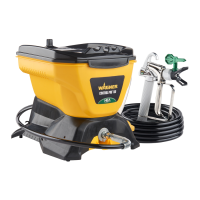
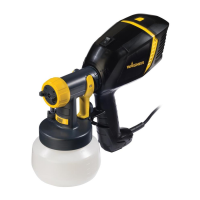
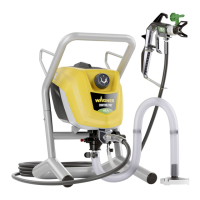
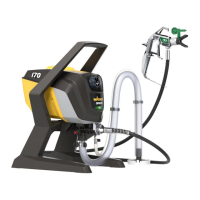
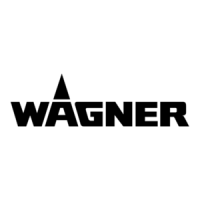

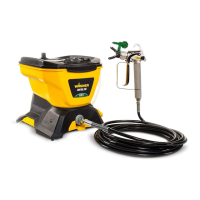
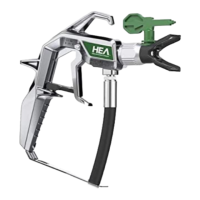
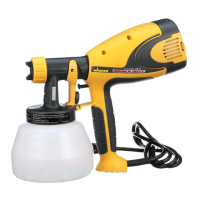
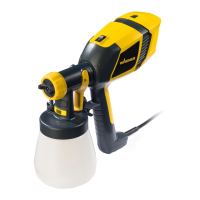
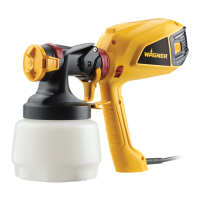
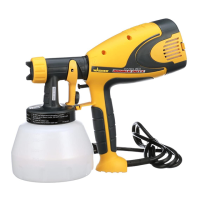
